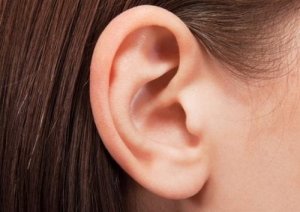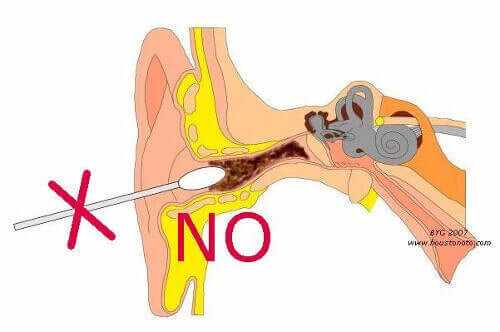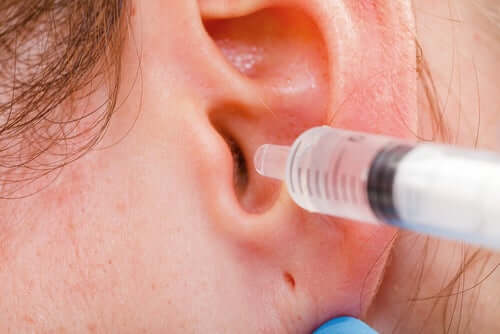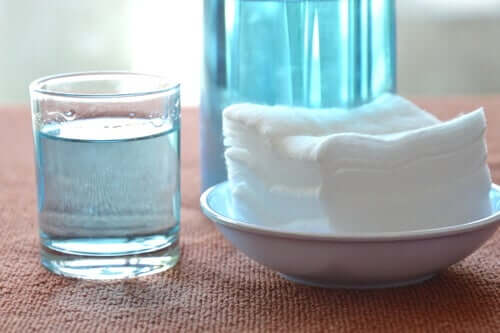Remove Earwax Blockage without Damaging Your Ears

Ear problems can afflict anyone at any age and are due to many various factors. If you’re experiencing hearing problems, you might need to remove earwax blockage. In this article, we’ll take a look at the best way to do so without damaging this organ.
What’s earwax?
Earwax is a substance produced naturally and its function is to protect our ears from bacteria and other harmful agents. Also, ear wax is a natural lubricant for the external ear canal. However, it often accumulates and it leads to all sorts of discomfort such as irritation, fullness, dizziness, itching and even partial hearing loss.
Consequences of not removing earwax blockage

It’s important to be aware of the most common causes of ear discomfort due to earwax buildup. This is because it can lead to irritation when there’s a blockage inside the ear canal. This accumulation is often due to the use of cotton swabs, which merely compress it inside the ear.
The same can happen with the use of other pointy objects, such as hairpins, you may use for removing surface wax. As with swabs, these types of elements merely push the wax into the ear and lead to blockage. People who use earplugs or headphones are also at a higher risk of having an excessive accumulation of earwax.
Also read: What Does Ringing in the Ears Mean?
Symptom
When there’s too much earwax in a person’s ears, they may display the following symptoms:
- Itching of the ear canal
- A plugged ear sensation
- Dizziness
- Ringing in your ear
- Ear discharge
- Hearing problems
- Earache
How to remove earwax blockage without damaging your ears
The following recommendations have a pattern in common. Basically, don’t introduce sharp elements in your ear canal. Cotton swabs were designed for the sole purpose of cleaning the superficial parts of the ear, and not the inside.
Here are some better options.
1. Saline solution

- To do this, simply mix a teaspoon of salt in ½ cup of water until it dissolves. You can also use a commercial serum if it makes you feel safer.
- Soak a piece of cotton with this mixture and drop a few drops of the solution into your ear canal while you slightly tilt your head sideways.
- Hold this position for a couple of minutes so the liquid can go into your ear. Then, tilt your head in the opposite direction to drain the solution.
2. Oil-based preparations
Oily preparations, usually sold in pharmacies, are one of the safest and most effective remedies for removing ear wax. Due to the oily nature of the wax, these oil-based preparations can help dissolve the cap for subsequent extraction.
- Put a few drops of this oil in your ear and let it work for about five minutes. Meanwhile, try not to move.
- Repeat this procedure for two days in a row so the earwax plug completely dissolves.
- As the last step, wash your ear with warm water to remove any traces of wax.
3. Hydrogen peroxide

- Mix equal parts of 3% hydrogen peroxide (no higher) and water. You could also use store-bought peroxide solutions for this purpose.
- Put a few drops of this mixture in your ear while you tilt your head so that the mixture goes into the ear canal.
- Leave the mixture in for a couple of minutes and then turn your head to the opposite side to drain the remaining liquid.
You may be interested: Seven uses you can give hydrogen peroxide as a natural remedy
4- Carbonated glycerin
Glycerin is a natural ingredient that can help soften the wax and facilitate its expulsion. You can purchase it in most drugstores.
- Apply 4 drops three times a day for best results.
5- Olive oil is a great way to remove an earwax blockage

Extra virgin olive oil is another great substance you can use to lubricate and loosen earwax to facilitate its removal.
- Put 2 or 3 drops of olive oil in the affected ear before bedtime and let do its thing
- Repeat 3 or 4 days in a row
These remedies can help you remove earwax plugs effectively. However, consult your doctor if the plug doesn’t dissolve entirely or if you experience new symptoms. Remember not to use any objects that will only lead to a greater accumulation of wax such as earplugs and earphones.
All cited sources were thoroughly reviewed by our team to ensure their quality, reliability, currency, and validity. The bibliography of this article was considered reliable and of academic or scientific accuracy.
- Burton, M. J., & Doree, C. (2018). Ear drops for the removal of ear wax. Cochrane Database of Systematic Reviews. https://doi.org/10.1002/14651858.CD004326.pub3.
- Instituto de Otorrinolaringología y Cirugía de Cabeza y Cuello de Madrid. Tapón de cera en los oídos: ¿cómo quitarlos). Diciembre 2018.
- Mayo Clinic. Oclusión por cerumen. Febrero 2021.
- Medline Plus. Tapón de cerumen. Biblioteca Nacional de Medicina de Estados Unidos. Abril 2020.
- Mills L. Ear wax removal and tinnitus. British Tinnitus Association. Diciembre 2020.
- Oron, Y., Zwecker-Lazar, I., Levy, D., Kreitler, S., & Roth, Y. (2011). Cerumen removal: Comparison of cerumenolytic agents and effect on cognition among the elderly. Archives of Gerontology and Geriatrics. https://doi.org/10.1016/j.archger.2010.03.025.
- Personal de Healthwise [Internet]. 20 de noviembre de 2017. Northshore University Healthsystem. [Consultado 2l 19, noviembre, 2018]. Disponible en: https://www.northshore.org/healthresources/encyclopedia/encyclopedia.aspx?DocumentHwid=earp4&;Lang=es-us.
This text is provided for informational purposes only and does not replace consultation with a professional. If in doubt, consult your specialist.








